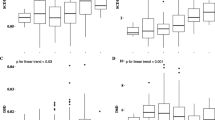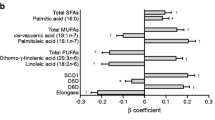Abstract
Changes in plasma fatty acid (FA) composition and desaturase activities are observed in metabolic syndrome (MS). However, whether these changes are a reflection of dietary intakes of fats and FAs is not well established. The current study was aimed at assessing plasma FA composition and desaturase enzyme activities as biomarkers of dietary intakes in subjects with MS. Case control study was done on 41 MS patients and was compared with age matched 45 controls. Dietary intakes, anthropometric and clinical parameters were measured. FA composition was analysed using gas chromatography-flame ionisation detector and desaturase enzyme activities were estimated as ratios of product to precursor FAs. Higher levels of 14:0, 16:0, 16:1, 18:1, D9D-18 activity and lower levels of 18:0 and 18:2 n-6 were seen in MS group when compared to controls (p < 0.05). Strong positive correlations were seen between plasma triglyceride (TG) levels and 14:0, 16:0, 16:1, 18:1, total saturated fatty acid, total monounsaturated fatty acid, and D9D activities, while 18:0, 18:2 n-6 and total polyunsaturated fatty acid were negatively correlated with TG. Positive correlations were seen between plasma 14:0, 18:1 and D9D-18 activity with total energy intake and carbohydrate (CHO) intakes but not with fat intake. Plasma FA profile appears to be a better index of total energy intake and CHO intake than fat intake, suggesting it might be a good reflection of endogenous FA metabolism. Changes in FA composition may therefore serve as an early index of dysregulation of FA metabolism, resulting in increased risk of MS.

Similar content being viewed by others
Abbreviations
- MS:
-
Metabolic syndrome
- CVD:
-
Cardiovascular disorder
- FA:
-
Fatty acid
- SFA:
-
Saturated fatty acid
- MUFA:
-
Monounsaturated fatty acid
- PUFA:
-
Polyunsaturated fatty acid
- D9D:
-
Delta D9 desaturase
- D6D:
-
Delta D6 desaturase
- D5D:
-
Delta D5 desaturase
- D4D:
-
Delta D4 desaturase
- CHO:
-
Carbohydrate
References
Mohan V, Rao G. Type 2 diabetes in South Asians. New Delhi: South Asian Society on Atherosclerosis and Thrombosis; 2007.
Prasad D, Kabir Z, Dash A, Das B. Abdominal obesity, an independent cardiovascular risk factor in Indian subcontinent: a clinico epidemiological evidence summary. J Cardiovasc Dis Res. 2011;2(4):199–205.
Misra A, Khurana L. The metabolic syndrome in South Asians: epidemiology, determinants, and prevention. Metab Syndr Relat Disord. 2009;7(6):497–514.
Misra A, Misra R, Wijesuriya M, Banerjee D. The metabolic syndrome in South Asians: continuing escalation and possible solutions. Indian J Med Res. 2007;125(3):345.
Kalupahana NS, Moustaid-Moussa N, Claycombe KJ. Immunity as a link between obesity and insulin resistance. Mol Aspects Med. 2012;33(1):26–34.
Cascio G, Schiera G, Di Liegro I. Dietary Fatty acids in metabolic syndrome, diabetes and cardiovascular diseases. Curr Diabetes Rev. 2012;8:2–17.
Ristic-Medic D, Vucic V. Dietary fats and metabolic syndrome. J Nutr Health Food Sci. 2013;1(1):8.
Shridhar K, Dillon PK, Bowen L, Kinra S, Bharathi AV, Prabhakaran D, et al. Nutritional profile of Indian vegetarian diets—the Indian Migration Study (IMS). Nutr J. 2014;13(1):1.
Gupta R, Lakshmy R, Abraham RA, Reddy KS, Jeemon P, Prabhakaran D. Serum omega-6/omega-3 ratio and risk markers for cardiovascular disease in an industrial population of Delhi. Food Nutr Sci. 2013;4(9):94–7.
Chatterjee P. India sees parallel rise in malnutrition and obesity. Lancet. 2002;360(9349):1948.
Baylin A, Kabagambe EK, Siles X, Campos H. Adipose tissue biomarkers of fatty acid intake. Am J Clin Nutr. 2002;76(4):750–7.
Klein-Platat C, Drai J, Oujaa M, Schlienger J-L, Simon C. Plasma fatty acid composition is associated with the metabolic syndrome and low-grade inflammation in overweight adolescents. Am J Clin Nutr. 2005;82(6):1178–84.
Kabagambe EK, Tsai MY, Hopkins PN, Ordovas JM, Peacock JM, Borecki IB, et al. Erythrocyte fatty acid composition and the metabolic syndrome: a National Heart, Lung, and Blood Institute GOLDN study. Clin Chem. 2008;54(1):154–62.
Warensjo E, Ohrvall M, Vessby B. Fatty acid composition and estimated desaturase activities are associated with obesity and lifestyle variables in men and women. Nutr Metab Cardiovas Dis. 2006;16(2):128–36.
Vessby B, Gustafsson IB, Tengblad S, Boberg M, Andersson A. Desaturation and elongation of fatty acids and insulin action. Ann N Y Acad Sci. 2002;967(1):183–95.
Bharathi AV, Kurpad AV, Thomas T, Yusuf S, Saraswathi G, Vaz M. Development of food frequency questionnaires and a nutrient database for the prospective urban and rural epidemiological (PURE) pilot study in South India: methodological issues. Asia Pac J Clin Nutr. 2008;17(1):178–85.
Hodson L, Skeaff CM, Fielding BA. Fatty acid composition of adipose tissue and blood in humans and its use as a biomarker of dietary intake. Prog Lipid Res. 2008;47(5):348–80.
Wang L, Folsom AR, Zheng Z-J, Pankow JS, Eckfeldt JH, Investigators AS. Plasma fatty acid composition and incidence of diabetes in middle-aged adults: the Atherosclerosis Risk in Communities (ARIC) Study. Am J Clin Nutr. 2003;78(1):91–8.
Sun Q, Ma J, Campos H, Hankinson SE, Hu FB. Comparison between plasma and erythrocyte fatty acid content as biomarkers of fatty acid intake in US women. Am J Clin Nutr. 2007;86(1):74–81.
Volk BM, Kunces LJ, Freidenreich DJ, Kupchak BR, Saenz C, Artistizabal JC, et al. Effects of step-wise increases in dietary carbohydrate on circulating saturated fatty acids and palmitoleic acid in adults with metabolic syndrome. PloS one. 2014;9(11):e113605.
Mayneris-Perxachs J, Guerendiain M, Castellote AI, Estruch R, Covas MI, Fito M, et al. Plasma fatty acid composition, estimated desaturase activities, and their relation with the metabolic syndrome in a population at high risk of cardiovascular disease. Clin Nutr (Edinburgh, Scotland). 2014;33(1):90–7.
Das UN. A defect in Δ 6 and Δ 5 desaturases may be a factor in the initiation and progression of insulin resistance, the metabolic syndrome and ischemic heart disease in South Asians. Lipids Health Dis. 2010;9(1):1.
Gray RG, Kousta E, McCarthy MI, Godsland IF, Venkatesan S, Anyaoku V, et al. Ethnic variation in the activity of lipid desaturases and their relationships with cardiovascular risk factors in control women and an at-risk group with previous gestational diabetes mellitus: a cross-sectional study. Lipids Health Dis. 2013;12(1):1.
Attie AD. Relationship between stearoyl-CoA desaturase activity and plasma triglycerides in human and mouse hypertriglyceridemia. J Lipid Res. 2002;43(11):1899–907.
Parks EJ. Effect of dietary carbohydrate on triglyceride metabolism in humans. J Nutr. 2001;131(10):2772S–4S.
Enser M. The role of insulin in the regulation of stearic acid desaturase activity in liver and adipose tissue from obese–hyperglycaemic (ob/ob) and lean mice. Biochem J. 1979;180(3):551–8.
Ntambi JM, Miyazaki M, Stoehr JP, Lan H, Kendziorski CM, Yandell BS, et al. Loss of stearoyl-CoA desaturase-1 function protects mice against adiposity. Proc Natl Acad Sci. 2002;99(17):11482–6.
Hulver MW, Berggren JR, Carper MJ, Miyazaki M, Ntambi JM, Hoffman EP, et al. Elevated stearoyl-CoA desaturase-1 expression in skeletal muscle contributes to abnormal fatty acid partitioning in obese humans. Cell Metab. 2005;2(4):251–61.
Warensjö E, Rosell M, Hellenius ML, Vessby B, De Faire U, Risérus U. Associations between estimated fatty acid desaturase activities in serum lipids and adipose tissue in humans: links to obesity and insulin resistance. Lipids Health Disord. 2009;8:37.
Hlavaty P, Tvrzicka E, Stankova B, Zamrazilova H, Sedlackova B, Dusatkova L, et al. Association of plasma lipids fatty acid composition with metabolic profile of Czech Adolescents. Physiol Res. 2015;64:S167.
Warensjo E, Riserus U, Vessby B. Fatty acid composition of serum lipids predicts the development of the metabolic syndrome in men. Diabetologia. 2005;48(10):1999–2005.
Li SW, Wang J, Yang Y, Liu ZJ, Cheng L, Liu HY, et al. Polymorphisms in FADS1 and FADS2 alter plasma fatty acids and desaturase levels in type 2 diabetic patients with coronary artery disease. J Transl Med. 2016;14:79.
Vaittinen M, Walle P, Kuosmanen E, Männistö V, Käkelä P, Ågren J, et al. FADS2 genotype regulates delta-6 desaturase activity and inflammation in human adipose tissue. J Lipid Res. 2016;57(1):56–65.
Clarke SD. Polyunsaturated fatty acid regulation of gene transcription: a molecular mechanism to improve the metabolic syndrome. J Nutr. 2001;131(4):1129–32.
Acknowledgement
This study was partly funded by Indian Council of Medical Research (ICMR), Government of India (RFC No. 5/4/5-11/10/NCD-II). We gratefully acknowledge all our study volunteers for their kind cooperation.
Author Contributions
All of the authors listed above have contributed to the work and have read, participated in the writing and agreed upon the submitted version of the manuscript.
Author information
Authors and Affiliations
Corresponding author
Ethics declarations
Conflict of interest
The authors have no conflict of interest to disclose.
Rights and permissions
About this article
Cite this article
Pavithra, N., Bannikoppa, P.S., Uthappa, S. et al. Plasma Fatty Acid Composition and Estimated Desaturase Activities Reflect Dietary Patterns in Subjects with Metabolic Syndrome. Ind J Clin Biochem 33, 290–296 (2018). https://doi.org/10.1007/s12291-017-0674-1
Received:
Accepted:
Published:
Issue Date:
DOI: https://doi.org/10.1007/s12291-017-0674-1




